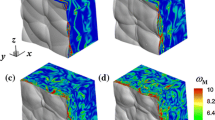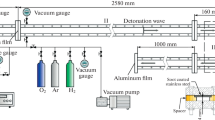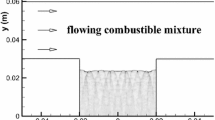Abstract
The characterization of the detonation dynamic parameters (detonability limits, direct initiation energy, critical tube diameter, etc.) requires a characteristic length scale for the detonation wave in the direction of propagation. However, most detonations are unstable, their reaction zones are turbulent, and their structure departs significantly from the idealized one-dimensional Zel'dovich-Von Neumann-Doring model. It is argued that the most suitable length scale to characterize a turbulent detonation wave is the location of the sonic surface, which separates the statistically stationary flow of the reaction zone structure from the unsteady expansions behind the wave. Previous real and numerical experiments are reviewed in order to determine the relation between the global location of the mean sonic surface and the chemical, mechanical, and thermodynamic relaxation processes occurring in the detonation wave structure. Based on the experimental evidence, we postulate that the structure of turbulent detonations can be modeled in the one-dimensional Zel'dovich-Neumann-Doring framework, with the turbulence effects as source terms in the momentum and energy equations. These source terms involve the relaxation rates for the mechanical fluctuations, thermal fluctuations and the chemical exothermicity towards equilibrium. In the framework of the idealized one-dimensional structure with source terms, the sonic surface location is governed by the balance between the competing source terms satisfying the generalized Chapman-Jouguet criterion. We recommend that future work in detonation research should be focused at: 1) acquiring a large experimental database for the mean detonation properties (detonation velocity, location of sonic surface and mean reaction zone profiles); 2) the development of the appropriate source terms involving the turbulent fluctuations in the averaged equations of motion.
Similar content being viewed by others
REFERENCES
K. I. Schelkin and Ya. K. Troshin, Gas-dynamics of Combustion, Mono Book, Baltimore (1965).
J. H. S. Lee, “Dynamic parameters of gaseous detonations,” Ann. Rev. Fluid Mech., 16, 311–336 (1984).
M. I. Radulescu and J. H. S. Lee, “The failure mechanism of gaseous detonations: experiments in porous wall tubes,” Combust. Flame, 131, 29–46 (2002).
I. O. Moen, A. Sulmistras, G. O. Thomas, et al., “Influence of cellular regularity on the behavior of gaseous detonations,” in: J. R. Bowen, J.-C. Leyer, and R. I. Soloukhin (eds.), Progress in Astronautics and Aeronautics, Vol. 106: Dynamics of Explosions (1986), pp. 220–243.
J. H. S. Lee, “The propagation mechanism of cellular detonation,” in: Proc. of the 24th Int. Symp. on Shock Waves, China (2004).
R. I. Soloukhin, “Nonstationary phenomena in gaseous detonation,” Proc. Combust. Inst., 12, 799–807 (1969).
J. H. Lee, R. I. Soloukhin, and A. K. Oppenheim, “Current views on gaseous detonation,” Astronaut. Acta, 14, 565–584 (1969).
R. I. Soloukhin, “Multiheaded structure of gaseous detonation,” Combust. Flame, 10, 51–58 (1966).
E. A. Lundstrom and A. K. Oppenheim, “On the influence of non-steadiness on the thickness of the detonation wave,” Proc. Roy. Soc. A., 310, 463–478 (1969).
R. A. Strehlow, “Detonation structure and gross properties,” Combust. Sci. Technol., 4, 65–71 (1971).
D. H. Edwards, A. J. Jones, D. E. Phillips, “Location of Chapman-Jouguet surface in a multiheaded detonation-wave,” J. Phys., D: Appl. Phys., 9, 1331–1342 (1976).
J. M. Austin, F. Pintgen, and J. E. Shepherd, “Reaction zones in highly unstable detonations,” Proc. Comb. Inst., 30, 1849–1857 (2005).
M. I. Radulescu, G. J. Sharpe, J. H. S. Lee, et al., “The ignition mechanism in irregular structure gaseous detonations,” Proc. Comb. Inst. 30, 1859–1867 (2005).
W. Jost, Explosion and Combustion Processes in Gases, McGraw-Hill, New York-London (1946).
G. Taylor, “The dynamics of the combustion products behind plane and spherical detonation fronts in explosives,” Proc. Roy. Soc. A, 200, No.1061, 235–247 (1950).
A. R. Kasimov and D. S. Stewart, “On the dynamics of self-sustained one-dimensional detonations: A numerical study in the shock-attached frame,” Phys. Fluids, 16, No.10, 3566–3578 (2004).
A. A. Vasil'ev, T. P. Gavrilenko, and M. E. Topchian, “On the Chapman-Jouguet surface in multi-headed gaseous detonations,” Astronaut. Acta, 17, 499–502 (1972).
M. Weber and H. Olivier, “The thickness of detonation waves visualized by slight obstacles,” Shock Waves, 13, No.5, 351–365 (2004).
A. I. Gavrikov, A. A. Efimenko, and S. B. Dorofeev, “A model for detonation cell size prediction from chemical kinetics,” Combust. Flame, 120, Nos. 1–2, 19–33 (2000).
G. J. Sharpe, “The structure of planar and curved detonation waves with reversible reactions,” Phys. Fluids, 12, No.11, 3007–3020 (2000).
W. Fickett and W. C. Davis, Detonation, University of California Press, Berkley (1979).
D. S. Stewart and J. Yao, “The normal detonation shock velocity-curvature relationship for materials with non-ideal equation of state and multiple turning points,” Combust. Flame, 113, 224–235 (1998).
Ya. B. Zel'dovich, “On the theory of the propagation of detonation in gaseous system,” Zh. Eksp. Teor. Fiz., 10, 542–568 (1940); also in NACA TM 1261 (1960).
A. A. Vasil'ev, V. V. Mitrofanov, M. E. Topchyan, “Detonation waves in gases,” Combust., Expl., Shock Waves, 23, No.5, 109–131 (1987).
Yu. N. Denisov and Ya. K. Troshin, “Pulsating and spinning detonation of gaseous mixtures in tubes,” Dokl. Akad. Nauk. SSSR, 125, 110–113 (1959).
F. Pintgen, C. A. Eckett, J. M. Austin, and J. E. Shepherd, “Direct observations of reaction zone structure in propagating detonations,” Combust. Flame, 133, No.3, 211–229 (2003).
A. A. Vasil'ev and Y. Nikolaev, “Closed theoretical model of a detonation cell,” Acta Astronaut., 5, 983–996 (1978).
V. Subbotin, “Two kinds of transverse wave structures in multi-front detonation,” Combust., Expl., Shock Waves, 11, No.1, 96–102 (1975).
M. I. Radulescu, G. J. Sharpe, and C. K. Law, “The Favre-averaged structure of turbulent cellular detonations,” in: Proc. of the 20th ICDERS, Montreal, Canada, July (2005).
G. J. Sharpe, “Transverse waves in numerical simulations of cellular detonations,” J. Fluid Mech., 447, 31–51 (2001).
A. Favre, “Equations des gas turbulents compressibles,” J. Mecanique, 4, 361–421 (1965).
B. V. Voitsekhovskii, V. V. Mitrofanov, and M. E. Topchian, Structure of a Detonation Front in Gases [in Russian], Izd. Akad. Nauk SSSR, Novosibirsk (1963).
D. R. White, “Turbulent structure of gaseous detonation,” Phys. Fluids, 4, 465–480 (1961).
R. Panton, “Effects of structure on average properties of two-dimensional detonations,” Combust. Flame, 16, 75–82 (1971).
S. S. Rybanin, “Turbulence in detonations,” Combust., Expl., Shock Waves, 2, No.1, 29–35 (1966).
Yu. A. Nikolaev and D. V. Zak, “Quasi-one-dimensional model of self-sustaining multifront gas detonation with losses and turbulence taken into account,” Combust., Expl., Shock Waves, 25, No.2, 103–112 (1989).
J. B. Bdzil, “Steady state two dimensional detonation,” J. Fluid Mech., 108, 195–226 (1981).
N. Peters, Turbulent Combustion, Cambridge University Press, Cambridge, UK (2000).
G. B. Kistiakowsky and P. H. Kydd, “Gaseous detonations. IX. A study of the reaction zone by gas density measurements,” J. Chem. Phys., 25, No.5, 824–835 (1956).
H. D. Ng, N. Nikiforakis, and J. H. S. Lee, “Head-on collision of a detonation with a planar shock wave,” in: Proc. of the 24th Int. Symp. on Shock Waves, China (2004); also H. D. Ng, B. B. Botros, J. Chao, et al., “Head-on collision of a detonation with a planar shock wave,” Submitted to Shock Waves, October (2004).
Author information
Authors and Affiliations
Additional information
__________
Translated from Fizika Goreniya i Vzryva, Vol. 41, No. 6, pp. 157–180, November–December, 2005.
Rights and permissions
About this article
Cite this article
Lee, J.H.S., Radulescu, M.I. On the Hydrodynamic Thickness of Cellular Detonations. Combust Explos Shock Waves 41, 745–765 (2005). https://doi.org/10.1007/s10573-005-0084-1
Received:
Issue Date:
DOI: https://doi.org/10.1007/s10573-005-0084-1




